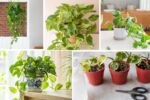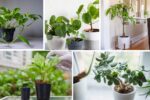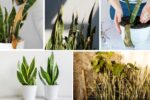If you’re looking to add striking visual interest to your garden or home, color-changing foliage plants are a must-have. These unique plants don’t rely solely on blooms for their beauty their leaves transform in color throughout the seasons, offering dynamic, ever-evolving displays. From fiery reds to golden yellows and deep purples, these plants create dramatic statements wherever they’re planted. Here are 10 gorgeous color-changing foliage plants that will elevate your space and keep your garden looking fresh and exciting year-round.
1. Japanese Maple (Acer palmatum)

Japanese Maples are renowned for their elegant, finely cut leaves and ever-changing foliage colors. In spring, their leaves emerge in soft shades of red or green, turning vibrant hues of orange, crimson, and gold in the fall. With countless cultivars to choose from, some even offer striking purple or burgundy tones throughout the summer. These deciduous trees or shrubs prefer partial shade and well-draining soil, making them perfect for adding graceful, artistic drama to gardens, patios, or as stunning container specimens.
2. Smoke Bush (Cotinus coggygria)

The Smoke Bush is a bold, deciduous shrub known for both its dramatic foliage and its cloud-like, wispy flowers that resemble puffs of smoke in summer. Its leaves shift beautifully from deep purple in spring to rich burgundy in summer, ending with fiery shades of orange, red, and amber in fall. This hardy plant thrives in full sun and well-drained soil, creating a spectacular focal point in garden beds and borders. It’s a perfect pick for anyone craving year-round foliage drama.
3. Coleus (Plectranthus scutellarioides)

Coleus is a true star when it comes to vibrant, color-changing foliage. Its large, velvety leaves come in endless combinations of green, purple, red, orange, yellow, and pink — often with intricate patterns. Depending on light exposure and temperature, the intensity and balance of these colors can shift dramatically through the growing season. Coleus thrives in both sun and shade, making it a versatile choice for hanging baskets, containers, and garden beds. Regular pinching encourages bushy growth and continuous color play.
4. Heuchera (Coral Bells)

Heuchera, or Coral Bells, are prized for their attractive, scalloped leaves that offer a stunning array of colors year-round. Depending on the variety, foliage can range from deep plum and bronze to lime green and silver, with seasonal shifts in hue and vibrancy. Some cultivars, like ‘Caramel’ and ‘Palace Purple,’ undergo noticeable changes from spring to fall. These hardy perennials prefer partial shade and well-drained soil and work beautifully in borders, woodland gardens, or as striking container plants.
5. Ninebark (Physocarpus opulifolius)

Ninebark is a resilient, multi-season shrub with stunning, peeling bark and colorful foliage that transforms throughout the year. In spring, its leaves emerge in rich burgundy or dark purple, transitioning to bronze or greenish tones in summer, before blazing into fiery reds and oranges in autumn. It also produces small clusters of white or pink flowers, adding seasonal interest. Ninebark thrives in full sun to partial shade and is perfect for mixed borders, privacy hedges, or as a bold statement plant.
6. Caladium (Caladium bicolor)

Caladiums are known for their vibrant, heart-shaped leaves splashed with shades of red, pink, green, and white. These tropical plants subtly change their color intensity with light exposure and temperature. Some cultivars display more vivid tones in summer, while others deepen in color during cooler weather. Caladiums flourish in shady spots with well-drained, fertile soil, making them perfect for underplanting in garden beds or brightening shaded patios and porches. Their color-changing qualities bring an exotic and artistic touch to any setting.
7. Sweet Potato Vine (Ipomoea batatas)

Sweet Potato Vines aren’t just for edible tubers their trailing foliage is a standout feature in ornamental gardens. Available in lime green, deep purple, bronze, and variegated varieties, the leaves subtly shift in tone depending on light, heat, and seasonal changes. As fall approaches, their colors often intensify, adding bold drama to hanging baskets and container arrangements. This fast-growing vine thrives in full sun to partial shade and looks stunning cascading over pots, retaining walls, or garden beds.
8. Oakleaf Hydrangea (Hydrangea quercifolia)

Oakleaf Hydrangeas are beloved for their large, lobed leaves that resemble those of an oak tree. In spring and summer, the foliage appears bright green, but as autumn sets in, the leaves turn breathtaking shades of crimson, burgundy, and deep purple. These deciduous shrubs also produce striking white flower clusters that fade to pink with age, adding another layer of seasonal interest. Preferring partial shade and moist, well-drained soil, Oakleaf Hydrangeas are perfect for woodland gardens and shaded borders.
9. Autumn Fern (Dryopteris erythrosora)

The Autumn Fern brings a subtle but beautiful color-changing touch to shaded areas. New fronds unfurl in shades of coppery orange or bronze in spring, gradually maturing to glossy, deep green throughout the summer. In fall, the older fronds may take on russet or gold tones before dying back. This hardy, easy-care fern thrives in shady spots with rich, well-drained soil, adding texture and soft movement to woodland gardens, shaded borders, or container arrangements on covered patios.
10. Red-Twig Dogwood (Cornus sericea)

While known primarily for its striking red stems in winter, the Red-Twig Dogwood also offers beautiful, color-changing foliage throughout the growing season. Leaves emerge a fresh green in spring, then gradually deepen and take on shades of yellow, red, and purple as autumn approaches. Its bright red branches become especially vivid when set against snowy winter landscapes, providing four-season interest. Thriving in full sun to partial shade, this shrub works wonderfully as a landscape hedge, border plant, or garden accent.



